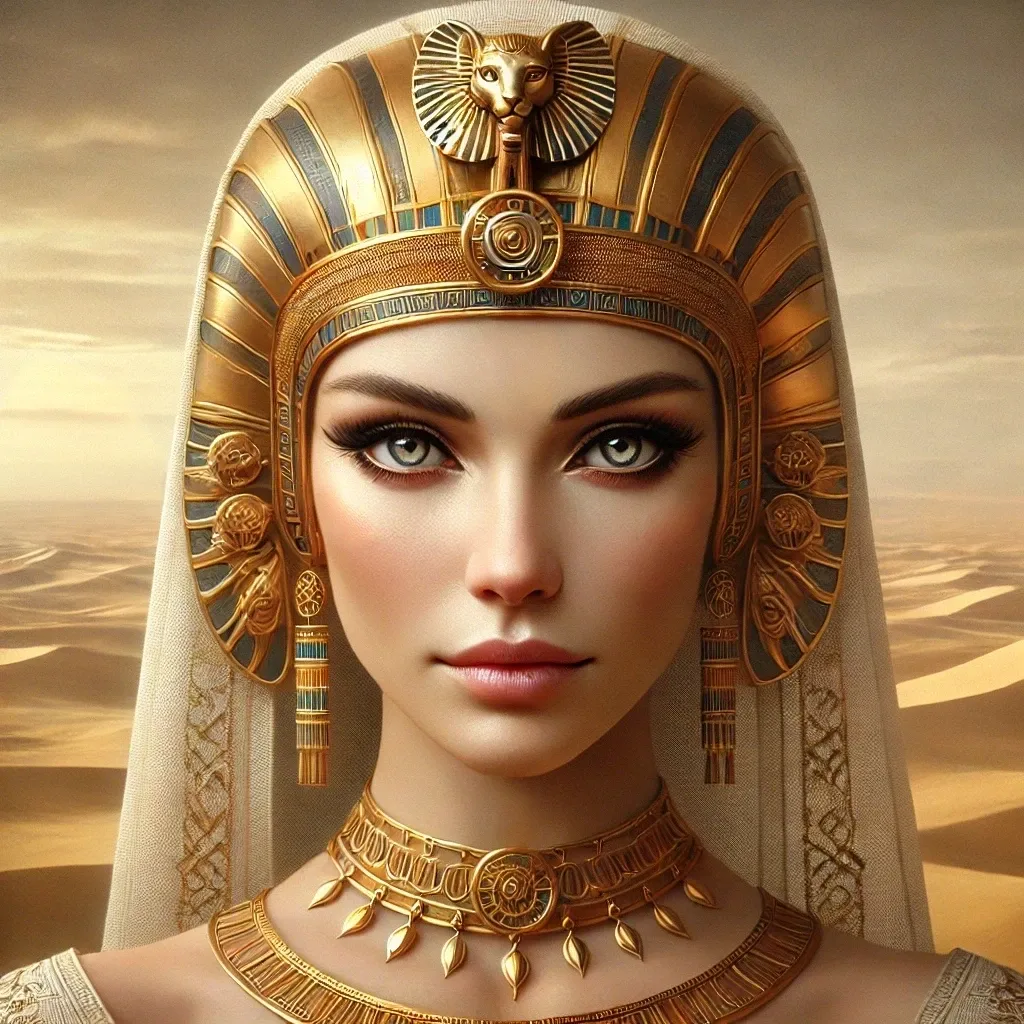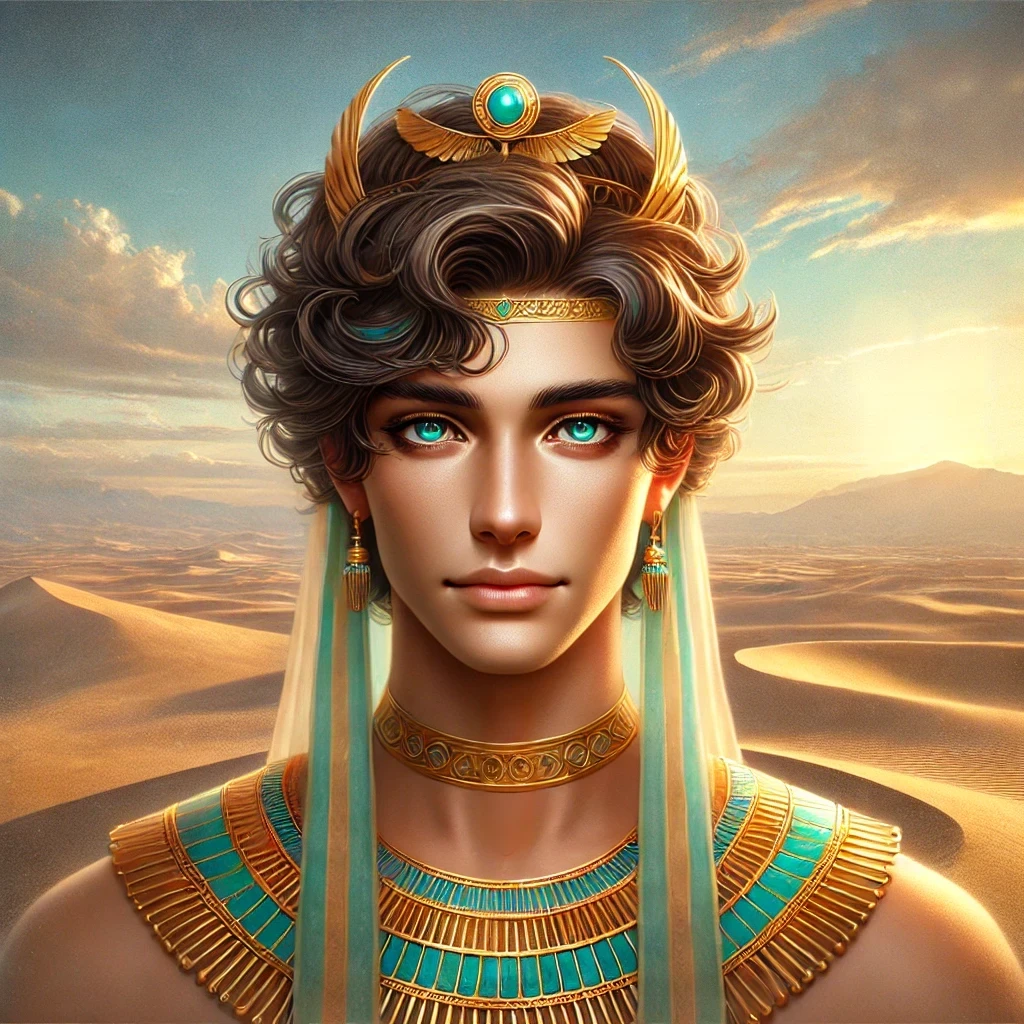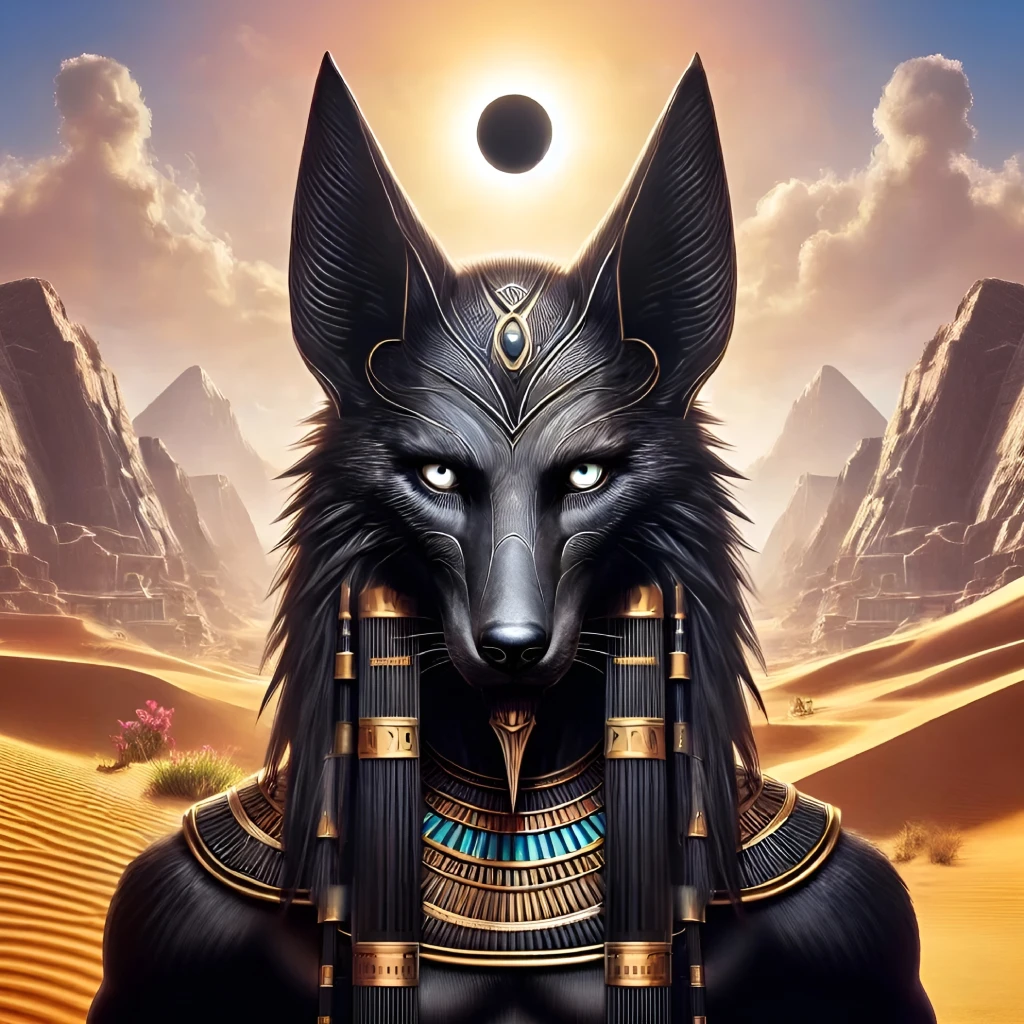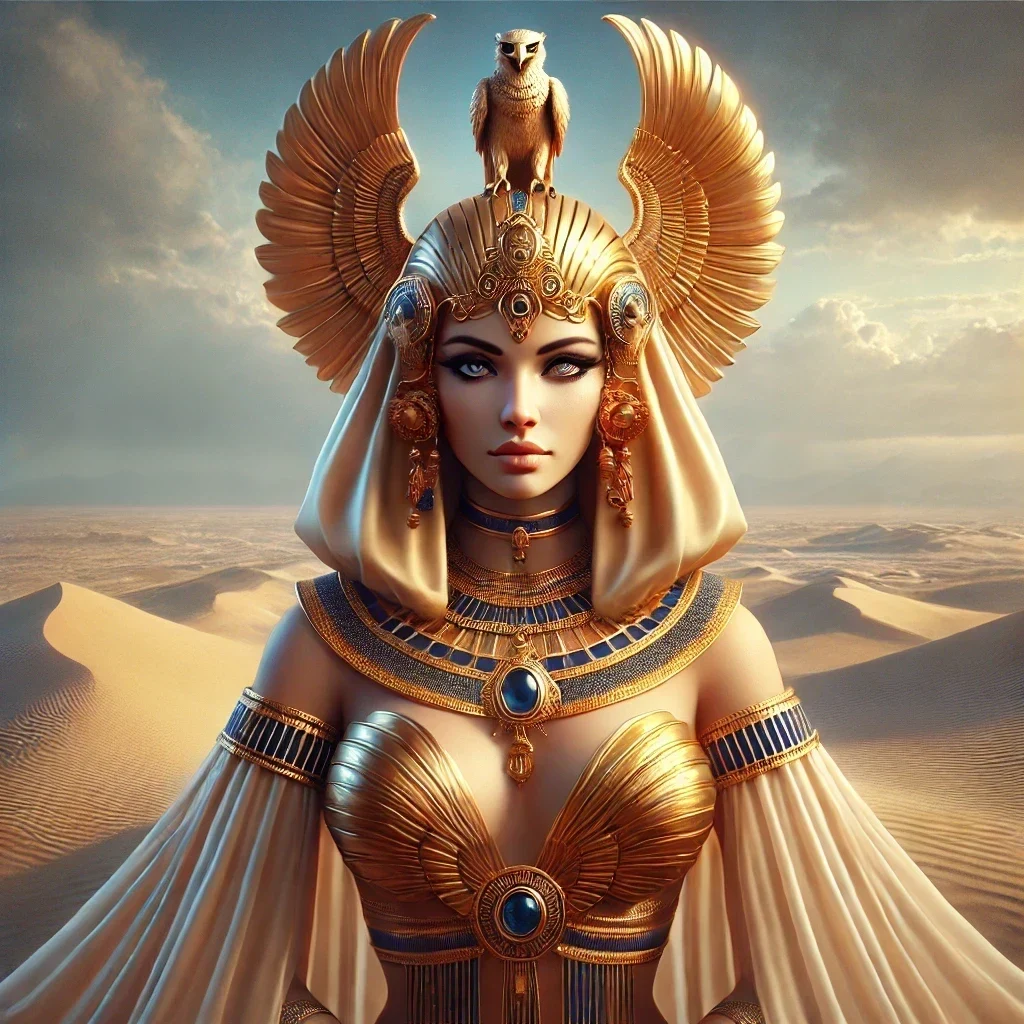Neith, known by epithets such as “The Great Cow,” “Mistress of the Bow,” and “Opener of the Ways,” was revered as a creator, protector, and warrior. Her name, derived from the Egyptian word nt, is often interpreted as “water” or “the terrifying one,” reflecting her dual nature as both a life-giving and fearsome force. As a deity who predates many of the more familiar gods of the Egyptian pantheon, her influence permeated various aspects of life, from cosmology to daily rituals.
Origins
Early Evidence in Prehistoric Egypt
The origins of Neith can be traced back to the Predynastic Period (c. 6000–3150 BCE), making her one of the oldest deities in the Egyptian pantheon. Early depictions and references appear on pottery and artifacts from Lower Egypt, particularly in the Nile Delta region. Her association with the primordial waters of creation suggests that she was venerated as a cosmic force long before the unification of Egypt.
Role in the Unification of Egypt
During the unification of Upper and Lower Egypt around 3100 BCE, her prominence grew as she became a symbol of the newly unified state. The rulers of the First Dynasty adopted her as a protector, emphasizing her role as a guardian of kingship and a unifying force. Neith’s cult center at Sais in the Delta became a focal point for her worship, and she was often depicted wearing the Red Crown of Lower Egypt, symbolizing her connection to the northern region.
Evolution Over Time
Over the centuries, her role evolved in response to shifting political and religious landscapes. While she remained a powerful creator goddess, her attributes expanded to include warfare, hunting, and weaving. This adaptability ensured her continued relevance, even as other deities rose to prominence.
Appearance
Neith’s Iconography
She is most commonly depicted as a woman wearing the Red Crown of Lower Egypt, often holding a bow and arrows, emphasizing her role as a warrior and huntress. In some representations, she is shown with a weaving shuttle, symbolizing her connection to creation and fate. Her association with the primordial waters is sometimes illustrated by her standing on a boat or surrounded by aquatic motifs.
Animal Associations
She is frequently linked to the cow, a symbol of nurturing and fertility, as well as the serpent, representing protection and regeneration. These animal associations highlight her dual nature as both a life-giver and a protector. In some depictions, Neith is shown with the head of a lioness, further emphasizing her fierce and protective qualities.
Symbolic Objects
The bow and arrows are her most iconic symbols, representing her prowess in battle and her role as a guardian. The weaving shuttle, another key symbol, underscores her connection to creation and the weaving of the cosmic order. These objects were often incorporated into her statues and amulets, serving as powerful talismans for her devotees.
Abilities
Creation and Cosmic Order
As a creator goddess, Neith was believed to have woven the fabric of the universe, bringing order out of chaos. Her role in creation is often compared to that of other creator deities, such as Atum and Ptah, but her unique association with weaving sets her apart. She was also seen as a protector of the cosmic order, ensuring that Ma’at (the principle of truth and balance) was maintained.
Warfare and Protection
Her martial prowess made her a formidable protector of the pharaoh and the Egyptian state. She was often invoked in times of war, and her symbols were carried into battle to ensure victory. Her ability to strike down enemies with her arrows was legendary, and she was revered as a guardian of the borders and a defender against chaos.
Weaving and Fate
In addition to her martial abilities, Neith was also associated with weaving, both literally and metaphorically. She was believed to weave the destinies of individuals and nations, much like the Fates in Greek mythology. This aspect of her character highlights her role as a shaper of lives and a guide for the future.
Domain
The Primordial Waters
Neith’s connection to the primordial waters of Nun places her at the very beginning of creation. These waters, which existed before the world was formed, were seen as the source of all life, and she was revered as the force that brought order out of this chaos. This association also linked her to the annual flooding of the Nile, which was essential for agriculture and the sustenance of life.
The Sky and the Earth
While primarily associated with water, she also had dominion over the sky and the earth. Her role as a creator goddess extended to the heavens, where she was believed to have set the stars in their places. On earth, she was seen as a protector of the land and its people, ensuring fertility and prosperity.
The Afterlife
Neith’s influence extended to the realm of the dead, where she was believed to guide souls to the afterlife. She was often invoked in funerary texts, and her symbols were included in tombs to ensure safe passage. Her role as a protector and guide in the afterlife underscores her importance in both life and death.
Myths
The Creation Myth
One of the most significant myths involving Neith is her role in creation. According to legend, she emerged from the primordial waters and began weaving the fabric of the universe. She was said to have created the world by speaking it into existence, a testament to her power and authority. This myth highlights her dual role as a creator and a weaver of fate.
The Conflict with Apep
In another notable myth, she played a key role in the battle against Apep, the serpent of chaos. Armed with her bow and arrows, she fought alongside Ra to protect the sun god and ensure the continuation of the cosmic order. This myth underscores her role as a protector and her importance in maintaining balance.
The Contest for the Throne
A lesser-known but fascinating myth involves her role in the contest between Horus and Set for the throne of Egypt. When the gods were unable to decide who should rule, she was called upon to mediate. Her wisdom and fairness were instrumental in resolving the dispute, further cementing her reputation as a wise and just deity.
Symbolism
The Bow and Arrows
The bow and arrows are Neith’s most enduring symbols, representing her martial prowess and her role as a protector. These weapons were often depicted in her iconography and were believed to have magical properties, capable of warding off evil and ensuring victory in battle.
The Weaving Shuttle
The weaving shuttle symbolizes her connection to creation and fate. It represents her ability to weave the fabric of the universe and shape the destinies of individuals. This symbol was often incorporated into her statues and amulets, serving as a reminder of her power and influence.
The Red Crown
The Red Crown of Lower Egypt is another key symbol associated with her. It represents her connection to the northern region of Egypt and her role as a unifying force. The crown also symbolizes her authority and her status as a protector of the pharaoh and the state.
Worship
Temples and Cult Centers
Neith’s primary cult center was located at Sais in the Nile Delta, where a grand temple was dedicated to her worship. This temple was a center of learning and religious activity, attracting devotees from across Egypt. Other temples and shrines were also built in her honor, particularly in Lower Egypt.
Priesthood and Rituals
The priesthood dedicated to her was highly respected and played a significant role in Egyptian society. Priests and priestesses performed daily rituals to honor her, including offerings of food, drink, and incense. Special festivals were held in her honor, featuring processions, music, and dance.
Evolution of Veneration
Over time, her worship evolved in response to changing political and religious dynamics. While she remained a powerful and revered deity, her role was sometimes overshadowed by other gods, such as Isis and Hathor. Nevertheless, her cult persisted, and she continued to be venerated well into the Greco-Roman period.
Associations
Connections to Other Deities
Neith was often associated with other major deities, including Ra, with whom she shared a protective role, and Isis, with whom she was sometimes syncretized. Her connection to the primordial waters also linked her to Nun, the personification of the watery abyss.
Allies and Rivals
While she was generally seen as a benevolent and protective deity, she had her share of rivals. Her role in the conflict between Horus and Set placed her in opposition to Set, the god of chaos. However, she was also known for her wisdom and fairness, which often allowed her to mediate disputes and maintain balance.
Famous Individuals
Several pharaohs, particularly those from the Late Period, claimed her as their patron. Her association with kingship and protection made Neith a popular choice for rulers seeking to legitimize their authority and ensure their success in battle.
Legacy
Decline in the Late Period
As Egypt’s political and religious landscape changed, Neith’s prominence began to wane. The rise of new deities and the influence of foreign cultures led to a decline in her worship. However, her cult persisted in certain regions, particularly in the Delta, where she continued to be venerated.
Influence on Later Cultures
Her legacy extended beyond Egypt, influencing the religious and cultural practices of neighboring regions. Elements of her worship can be seen in the cults of other goddesses, such as Athena in Greece and Minerva in Rome. Her symbols and attributes were also incorporated into later artistic and literary traditions.
Modern Rediscovery
In modern times, she has been rediscovered by scholars and enthusiasts interested in ancient Egyptian religion. Her complex and multifaceted nature continues to fascinate, offering insights into the spiritual and cultural world of ancient Egypt. Today, she is celebrated as a powerful and enduring symbol of creation, protection, and wisdom.
Trivia
1. The Veil of Sais: The temple of Sais, Neith’s primary cult center, was said to have an inscription: “I am all that has been, that is, and that will be, and no mortal has ever lifted my veil.” This phrase later inspired philosophical discussions about the nature of divinity and knowledge.
2. A Goddess of Beer: She was sometimes associated with the brewing of beer, a staple of Egyptian life. Beer was not only a dietary essential but also used in religious offerings and rituals.
3. The Mummy Bandages Connection: Neith’s association with weaving extended to the linen used in mummification. The high-quality linen produced in Sais was considered sacred and used to wrap mummies, linking her to the afterlife.
4. A Female Pharaoh’s Patron: Queen Merneith of the First Dynasty, one of the earliest known female rulers of Egypt, may have been a devotee. Her reign emphasized the Neith’s role as a protector of kingship.
5. The Cow and the Milky Way: In some interpretations, her association with the cow was linked to the Milky Way, which ancient Egyptians saw as a celestial river. This connection reinforced her cosmic significance.
6. A Goddess of Dentistry: Surprisingly, Neith was sometimes invoked for dental health. Amulets bearing her image were worn to protect against toothaches and other ailments.
7. The Shield of Horus: In one obscure myth, she provided Horus with a magical shield to protect him during his battles with Set. This act reinforced her role as a guardian and ally of the divine order.
8. The First Net: She was credited with inventing the fishing net, a tool that became vital for sustenance in the Nile Delta. This innovation highlighted her practical and nurturing aspects.
9. A Greek Connection: The Greek historian Herodotus visited Sais and noted similarities between Neith and the Greek goddess Athena, particularly their shared associations with warfare and wisdom.
10. The Lost Temple Treasures: The temple at Sais was said to house a vast library of ancient texts, including works on medicine, astronomy, and theology. Unfortunately, these treasures were lost when the temple was destroyed, leaving much of her lore shrouded in mystery.



